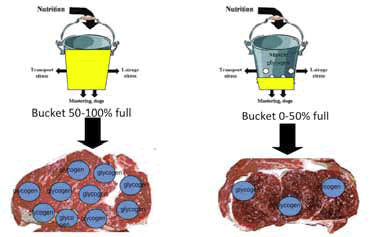Achieving satisfactory glycogen levels
High levels of glycogen (animal sugar) in the muscle at slaughter is essential for optimal meat quality. Meat with high levels of glycogen will be tenderer, juicer, lighter in colour, have better flavour and keeping quality.
Glycogen is used as the primary energy source as muscle turns into meat. Glycogen is held in reserve for vigorous muscular activity or times of stress.
The muscle glycogen bucket

Good nutrition results in a high and normal concentration of glycogen in muscle tissue and reduces the risk of slaughter animals developing high pH meat.
A muscle glycogen bucket less than half full at slaughter leads to meat that has a high pH, poor flavour and poorer keeping quality. It is visually unattractive, tougher and takes longer to cook than low pH meat.
To ensure the glycogen bucket is full, aim for a weight gain of at least 100g/day for crossbred lambs and 150g/day for merinos.
The other important factor in maintaining glycogen levels is management of animals for minimum stress. Merino sheep are more stress sensitive during the pre-slaughter period so additional care should be taken. Short term fasting has little effect on glycogen levels.
Managing pre-sale liveweight - carcase weight loss
Animals lose weight rapidly during the first 12 hours held off feed (there is a 5% and 7.5% decline in liveweight at 12 and 24 hours respectively) due mainly to emptying of the gut and faecal expulsion. Most processors require at least 24–36 hours off-feed before trucking (the on-farm feed curfew period) to reduce contamination of the truck with manure and associated soiling of animal pelts and likely processor discounts.
Carcase weight loss in lambs starts at 12 hours off-feed at a rate of 0.1%/hour for the next 36 hours. Reducing the total time off-feed in the pre-slaughter period from 48 to 36 hours will improve carcase weight by 0.24kg (for a starting carcase weight of 20kg ie, 20 x 0.001 x 12 = 0.24).
Dehydration in slaughter lambs causes a reduction in both dressing percentage and carcase weight. If possible, train lambs to drink from troughs so they may be more inclined when in lairage to drink from the stock water points in the pens.
Health management affecting carcase and offal quality
Healthy animals grow faster and are more efficient at converting feed into liveweight gain. Specific problems affecting carcase and offal quality and yield (especially in older sheep) are cheesy gland and ovis abscesses.
Achieving fat scores
As a general rule, when finishing lambs on high energy diets, such as high-quality pasture or grain, in the 35–45kg liveweight range a gain of 7kg liveweight will increase the fat score by 1. Genetic merit for muscle and leanness of the breeding flock (see tool 9.9 in Gain from Genetics), sex and level of nutrition all have an influence.
Managing skin quality and value
Skins can be a valuable product in the sheepmeat enterprise and can contribute from 5% to 20% of the value paid for lambs and sheep. A number of management factors affect skin quality and value. Applying best management practices in the production system improves skin quality and financial returns.
|
Skin quality concerns
|
Corrective action
|
|
Wool length
|
Match shearing to reduce grass seeds. Allow 10 weeks of wool growth after shearing and before slaughter to ensure commercial wool length
|
|
Wool quality
|
Dark fibres will reduce skin value. Hairy breeds and crosses have reduced value
|
|
Seeds and burrs
|
Manage grass seed load in paddocks and at shearing time
|
|
Grain strain
|
Do not handle sheep by holding the wool
|
|
Skin weight and area
|
Large lambs and sheep have a larger skin area and potentially more value
|
|
Misuse of brands and markers
|
If the dyes do not scour out they should be applied to the wig/head area
|
|
Over-crutching
|
A bung whole crutch is all that is needed to ensure easy dressing during processing
|
|
Vaccination abscess
|
Vaccinate near the edge of the pelt, behind the ear
|
|
Disease
|
Control fly strike, fleece rot, lumpy wool and lice to minimize wool matting
|
|